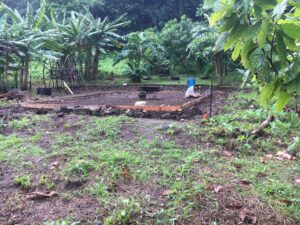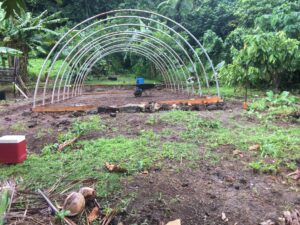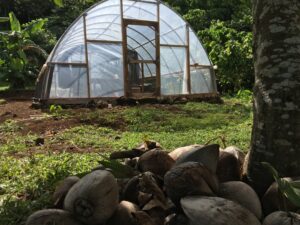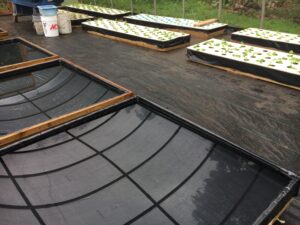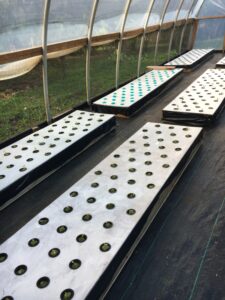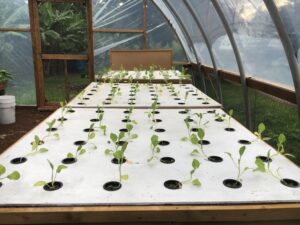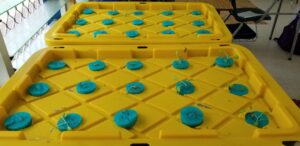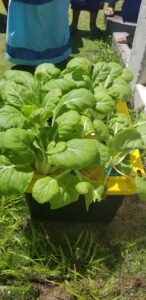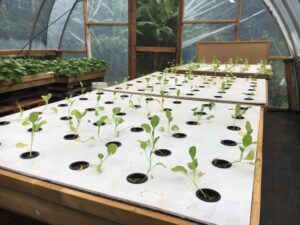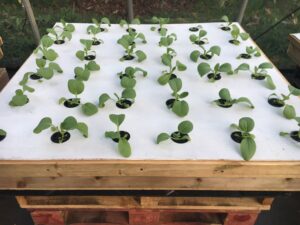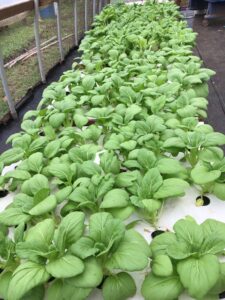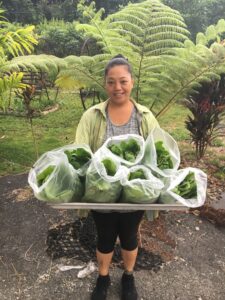Final report for FW19-352
Project Information
Agricultural productivity of Kratky’s non-circulating hydroponics method in cropping specialty vegetables for limited resource growers in Manu’a.
ABSTRACT
This project aims to research and quantify the key benefits of Kratky’s non-circulating hydroponics system for a limited resource grower in Manu’a; The project took place on a small farm on the remote island of Ta’u-Manu’a, one of the five main islands and two coral atolls that make up the territory of American Samoa. The Manu’a islands have a high percentage of its population being of Native Samoan ancestry and the community continue to preserve their rural traditions and lifestyle. However, the quality of life and food security of the people are dependent on a steady import of processed foods, fruits and vegetables from the main island of Tutuila. Annual heavy rainfall in the region exposes plants to dense forest pests, disease, and competition to fast growing weeds. Poor farming techniques, and limited resources on island are factors to significant losses, reduced production, and a stand-still of agricultural growth in the previous years. The opportunity to implement this project will pilot a modern method of farming that will raise awareness of healthy lifestyles, developments in agriculture, and encourage sustainability in Manu'a communities.
Research will focus on the successful production of bok choy and lettuce varieties through Kratky's non-circulating hydroponics in a greenhouse environment, and how it can open up avenues that will allow the community to target methods of sustenance and sustainability. Comparisons of various hydroponics methods implemented in American Samoa were evaluated to choose the best method that would work best. Kratky’s method was researched and tested on the farm for a few months before the analysis of all the data, and production of educational resources for community outreaches.
Due to COVID-19 pandemic, minor educational and outreach efforts were modified to follow social distancing rules and restrictions. Project was ongoing with the use of phone and internet communications. Demonstrations were implemented in several locations instead of just the farm as originally intended. The program was implemented to two elementary schools serving grade levels 4 to 8, the only high school on island serving grades 10 and 12, and finally to the Executive Office Building in Ta’u Manu’a consisting of twelve different government agencies, and interested community members.
A powerpoint presentation on the process of photosynthesis and hydroponics was followed by a demonstration activity that allowed participants to experiment and collect on the growth of bok choy plants for a period of 4-5 weeks. Participants were able to witness the development in plants by recording the changes in color, size, disease and pest attacks over the weeks using a data collection worksheet. Participants were able to identify the importance of key elements needed for a plant to grow, such as the sun. The two elementary schools identified a decrease of plant growth when plants were not getting enough sunlight in the early weeks and were able to move plants to a sunny location, which then allowed the plants to excel. Weekly visits to sites were routine. After 5-8 weeks depending on the plant developments from each site, a culminating event to harvest and create a lunch meal using the grown produce concluded our program.
In conclusion, a "Teacher's Hydroponics Resource Kit" was the product of this project. Lesson plans were formatted to fit the American Samoa Department of Education common core state standards modified for English Language Learners. The resource kit may be modified by teachers to implement various lessons that will focus on “growing your own food” “sustainability” “youth entrepreneurial opportunities” and “educational and career paths” to name a few. Although this project has reached its end date, a greenhouse tour of the greenhouse demonstration of Kratky’s non-circulating hydroponics is intended for community members in future.
List of Objectives:
- Construct a demonstration greenhouse site for the use of Kratky’s non-circulating hydroponics.
- To research, implement and utilize Kratky’s non-circulating hydroponics system to maximize yields and quality Bok Choy & Lettuce varieties in Manu’a; and Research feasibility of Kratky’s non-circulating hydroponics and determine sustainability of the system for use within the community.
- To implement awareness outreach workshops on hydroponics, food insecurities and methods of sustainability in Manu'a communities.
We will accomplish these objectives with the help of technical assistants, local agricultural professionals and project team. We were able to tour and receive training and advice from visits to local hydroponic farms on the main island of Tutuila in April 2019. Between April 2019 and February 2020, the farmer has been able to travel to Tutuila for follow-ups with the project team. Communication and support between the project team have been active and mainly via phone and email.
This project will provide valuable experiences to the farmer, technical staff, community and limited resource growers in Manu’a, through the sharing of information through outreaches, demonstrations, and dissemination of research findings.
Timeline of Events:
|
Activity |
Start Date |
End Date |
Duration |
Percent Complete |
|
Hydroponics Training |
6/10/19 |
07/19/19 |
6 weeks |
|
|
Greenhouse Construction |
8/05/19 |
8/09/19 |
1 week |
|
|
Resevoir Construction & Setup |
8/12/19 |
8/16/19 |
1 week |
|
|
Planting Stage |
8/19/19 |
9/13/19 |
4 weeks |
|
|
Harvesting & Replanting |
9/16/19 |
8/07/20 |
12 months |
|
|
Field Day Demonstration |
October 2019 |
|
2 Days |
|
|
Brochures & Fact Sheets |
September 2019 |
|
30 Days |
|
|
School Visits |
November 2019 |
December 2019 |
2 months |
|
|
Data Collection |
Aug. 2019 |
Aug. 2020 |
1 year |
|
|
Last Day of Project |
|
Aug. 7, 2020 |
|
|
Cooperators
- - Producer
- - Technical Advisor - Producer (Educator)
- (Educator)
- - Producer
Research
List of Objectives:
- Construct a demonstration greenhouse site for the use of Kratky’s non-circulating hydroponics.
- To quantify economics of vegetable production, including the following parameters: cost of seed; cost of establishment; nutrient contributions; monitor for pest & disease; management costs; produce yield and quality.
- To implement awareness outreach workshops on hydroponics, food insecurities and methods of sustainability in Manu'a communities.
Objectives were met with the help of technical assistants, local agricultural professionals and project team. Active communication and technical support between the project team have been mainly via phone and email due to COVID-19 restrictions.
Objective One
- Construct a demonstration greenhouse site for the use of Kratky’s non-circulating hydroponics.
Methods
- Survey and prepare the project site.
- The project started with clearance and preparation of site on a 30 x 40 sq. ft. area with the help of community members/farmers with access to an excavator.
- The construction of an 18 x 30 sq. ft. greenhouse was then implemented. The purpose of the greenhouse is to shelter hydroponic bok choy and lettuce varieties as well as control pest and disease to ensure maximized growth in yields.
- A hoop house template design was used in this project. Information and eBook by farmer Steve Robinson of Self-Sufficient-Farm-Living.com, which can be found online.
- This step took a little over two months due to transportation of materials inter-island. When all building structure arrived, the construction of the demonstration greenhouse began, which took about 3 weeks, depending on weather conditions.
- Pictures of the structure are attached.
Objective Two
- To quantify economics of vegetable production, including the following parameters: cost of seed; cost of establishment; nutrient contributions; monitor for pest & disease; management costs; produce yield and quality.
- To research, implement and utilize Kratky’s non-circulating hydroponics system to maximize yields and quality Bok Choy & Lettuce varieties in Manu’a.
- Research feasibility of Kratky’s non-circulating hydroponics and determine sustainability of the system for use within the community.
Methods:
Steps for this objective included the collection of research-based resources online, articles, videos and reading material provided by local horticulturists and hydroponics farmers. Farmer was able to travel to sister-island to tour and interview local hydroponics farmers there, for tips on making this project feasible and beneficial for the community. It was a great way to see first hand different hydroponics methods, taking in rich content and information on the process of plant growth and growing methods, as well as the awareness of successful agricultural developments in our community and region.
After the construction of the greenhouse structure, tables and systems were then built and set up. Water had already been gathering in 55 gallon water catchment setups during downpours. 5 gallon buckets were used to transport water from 55 gallon water containers to fill 9 4x8 tables. Nutrient water was then prepared using the instructions of Master Blend hydroponics nutrient, with the aid of the Master Blend Calculator App. A handy and resourceful tool. This and all the materials and resources collected for this project allowed successful mock experiments to test parameters that would affect the operations implementation of activities for the community.
This project was able to address the economics of vegetable production in Manu’a communities in different areas. Farmer was able to identify how this project can be a model system for entrepreneurial opportunities and earn income for the farm. The cost of all materials, shipping and expenses for this project such as seeds, nutrients, and management costs were some elements collected and analyzed in achieving project goals. Data from monitoring pest and disease as well as production, yield and quality allowed the farmer to better understand the management of resources for a remote small scale farm production. The project has been helpful in raising awareness and an understanding as well in the community in terms of the quality production of fresh produce in Manu’a, and future projects that cater to the movement of “Growing Food for Manu’a” communities.
Note: Current Events that affected scheduled events for this project:
- In September of 2019, a Measles outbreak in American Samoa shifted some events for this project.
- In February of 2020, American Samoa faced a few tropical storms due to several tropical depressions over the islands, which lasted about three weeks.
- In March of 2020 as the measles outbreak declaration was being lifted, an official state of emergency had been declared for the COVID-19 pandemic.
- Because of COVID-19 rules and regulations, there were minor modifications made to meet social distancing practices without taking away from the integrity of this project, such as the mobilization of demonstrations with the goal to culminate all outreach workshops with a tour activity of the demonstration greenhouse.
- Harvests were given to local school meal programs, elderly meal programs, interested community members that visited the farm during the project, and any access then sold for farm income.
Objective Three
- To implement an Awareness Outreach workshop on hydroponics, food insecurities and methods of sustainability in Manu'a communities.
This objective was implemented in schools, government agencies, and village groups. All participating schools and organization demonstrations were implemented at their designated locations. Activities were mobilized and designed to meet social distancing regulations.
Workshops and experiments were ongoing from October 2020 and lasted through March. A tour of the demonstration greenhouse is scheduled in June, which will invite participants and community members.
Data on methods and opportunities for small farm income and options to develop sustainability for Manu’a communities were also collected throughout the process of this project.
Project product included a “Teacher's Hydroponics Resource Kit.” Lesson/Unit plan include standards that meet American Samoa Department of Education standards, modified for English Language Learners from national common core standards. All activities are tangible and may be modified to meet different audiences. Lessons are based on the theme of being able to “Growing food for Manu'a” and an integration of academic subjects; such as Science, and College, Career & Life Planning courses for grades 4-12.
This project was also implemented as an informational awareness presentation for a group of local Government Agencies, farmers and interested community members at designated sites.
- DEMONSTRATION AGENDA
Growing Food for Manu'a (Unit Plan);
- Photosynthesis Lesson
- Hydroponics Lesson
- Hydroponics Demonstration
- Harvest Demonstration & Culminating event
- Demonstration Hydroponics Greenhouse Tour
Conventional systems used previously in growing bok choy and lettuce were based on basic knowledge and unsuccessful attempts due to lack of experience and knowledge of farming methods. Crop yields were poor due to soil nutrient deficiencies, heavy rain downpours, extreme weather and pest attacks.
Objective One Results & Discussion:
The objective to construct a demonstration greenhouse site for the use of Kratky’s non-circulating hydroponics was achieved with the research and study of a DIY(Do it yourself) model found online. Farmer received tips and advice from Technical Specialist on organization of materials and resources, preparation, transportation of materials inter-island as well as construction. Demonstration involved community helpers, and was well structured and secure.
Objective Two Results & Discussion:
To research and experiment using Kratky’s non-circulating hydroponics system to maximize yields and quality of Bok Choy & Lettuce varieties in Manu’a; its feasibility and sustainability for Manu’a communities.
|
|
|||
|
Hydroponic Beds:
|
Hydro-beds were built with 1x6 lumber for framing, and used a quarter inch plywood for the base of the hydro-bed and covers. Originally wanted to use styrofoam covers, but by advice of tech support and for budget reasons, plywood was convenient and available locally. Black plastic material was used to line each bed, and 2-inch holes were drilled for covers. |
||
|
Water:
|
For water supply, a total of ten 55-gallon rainwater containers were used for rainwater catchment. Containers were placed appropriately at various catchment sites around the farm. Over-showers and heavy rainfall provide a continuous source of water for hydro-beds. Screens and filter materials placed over catchment to separate any debris and insects that may contaminate and develop in water. 5 gallon buckets were used to transport water to hydro-beds. |
||
|
Nutrients & Management
|
Nutrient EC and pH level monitoring on a weekly basis. Nutrients are calculated per gallon of water used in each reservoir. Master Blend Nutrient mix is used in this project. For 1 gallon of water, 2 grams of MB, 2 grams of Calcium nitrate, and 1 gram of Epsom salt may be used according to manufacturer instructions. Researchers may calculate based on container volume, or use an online Master Blend calculator available for various plants. Nutrients are carefully calculated for the size and volume of each bed as instructed in manual. TDS/PPM or EC meter is used to check strength of nutrient solution, and pH meter is used to check appropriate pH levels for plants. |
||
|
Scheme:
|
Mock sequential plant-to-harvest systems. To create a systematic growth and harvest plan, seeds are started at least two to three weeks before planting in the six 4x4 hydro-beds. The next set of seedlings are transplanted approximately a week or two in the six 2x8 hydro-beds. After transplanting, nutrient and water calibrations, plants take about 45 days to harvest. Data on plant growth showed that size of beds, and volume of nutrient water affected growth of plants. Spacing plants based on seedling details are eminent in the successful growth of each plant. |
||
Objective Three Results & Discussion:
To implement awareness outreach workshops on hydroponics, food insecurities and methods of sustainability in Manu'a communities.
Workshop objectives were a great success. Early planning allowed project team to create a smooth program in accordance with COVID-19 regulations. Due to travel restrictions and limitations inter-island, demonstrations were then catered to on a one-on-one approach. Demonstrations for schools, interested government agencies, farmers and interested community members were participants of this project.
A "Teacher's Hydroponics Resource Kit" was created as a product of this project. Teachers in participating levels were able to receive a copy of lesson plans and resources used in the implementation of demonstrations in schools. The kit includes a lesson plan, power point presentation with educational links and videos on Photosynthesis & Hydroponics, and a slide show depicting demonstrations and culminating events.
Research outcomes
Education and Outreach
Participation summary:
Awareness workshops were planned and implemented to the elementary schools and high school on island. The workshop included a presentation to grades levels 4 to 8. A power point presentation introduced project objectives, and educational videos on Photosynthesis and Hydroponics. Teachers were encouraged to modify objectives to student levels, and use the lesson plan as a guide in Science lessons and activities.
Demonstrations were implemented in each school, with follow-up visits weekly up until harvest. Participants were able to take data on plant development, which included a data collection form for size, color, pest & disease. Students helped with harvest, and we were able to create a dish using fresh produce for lunch. The same for high school participants and general public.
Overall, visits and culminating ranged from the month of October 2020 to March 2021, as more community members are inquiring about hydroponics farming.
Educational Materials to be Produced:
- A "Teacher's Hydroponics Resource Kit" was a product of this project. Lesson plans were designed based on American Samoa Department of Education standards and benchmarks, modified for English Language Learners, and adopted from U.S. common core standards. The teaching resource kit is available as a guide to Science lessons for elementary students, Science and Life & Career courses for high school students, and then informational resource for the community and interested farmers.
Education and Outreach Outcomes
Changes in Knowledge: There is a growth and development of information and knowledge throughout the progress of this project for proper and best pest control, use of resources and raw materials, grow mediums, plant nutrients, seedlings and an awareness that there is continuous growth in the adoption of Kratky's system.
Changes in Attitude: Researcher/Farmer attitude has grown in terms of the achievements thus far for this project. Keeping a positive attitude has allowed us to surpass the challenges for this project, which is still ongoing and has been key to developing a confidence in the work and knowledge acquired from this experience.
Changes in Skills/Awareness: Organizational and operations system development and planning have allowed us to manage the successful growth of seedlings from germination, to water harvesting, transplanting in hydro-beds and then harvesting and packaging of crops. We have also gained insight on improvements that need to be made along the way and management of resources to expand and sustain.
